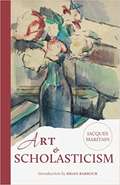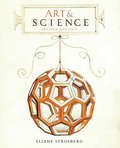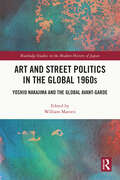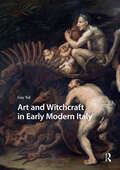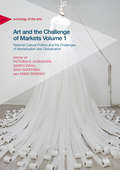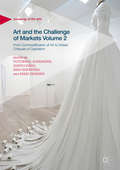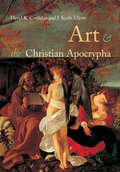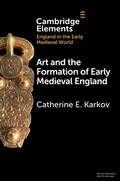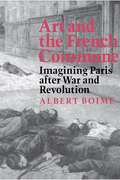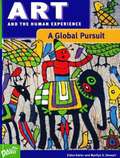- Table View
- List View
Art and Revolution
by John BergerIn this prescient and beautifully written book, John Berger examines the life and work of Ernst Neizvestny, a Russian sculptor whose exclusion from the ranks of officially approved Soviet artists left him laboring in enforced obscurity to realize his monumental and very public vision of art. But Berger's impassioned account goes well beyond the specific dilemma of the pre-glasnot Russian artist to illuminate the very meaning of revolutionary art. In his struggle against official orthodoxy--which involved a face-to-face confrontation with Khruschev himself--Neizvestny was fighting not for a merely personal or aesthetic vision, but for a recognition of the true social role of art. His sculptures earn a place in the world by reflecting the courage of a whole people, by commemorating, in an age of mass suffering, the resistance and endurance of millions. "Berger is probably our most perceptive commentator on art...A civilized and stimulating companion no matter what subject happens to cross his mind."--Philadelphia InquirerFrom the Trade Paperback edition.
Art and Revolution in Modern China: The Lingnan (Cantonese) School of Painting, 1906-1951 (Center for Chinese Studies, UC Berkeley #29)
by Ralph CroizierThis title is part of UC Press's Voices Revived program, which commemorates University of California Press’s mission to seek out and cultivate the brightest minds and give them voice, reach, and impact. Drawing on a backlist dating to 1893, Voices Revived makes high-quality, peer-reviewed scholarship accessible once again using print-on-demand technology. This title was originally published in 1988.
Art and Revolution: Ernst Neizvestny and the Role of the Artist (The Essential John Berger)
by John BergerA wrenching portrait of the Russian sculptor and a tribute to the potential of political artJohn Berger explores the life and work of Ernst Neizvestny, who, after clashing with Khrushchev, was excluded from the ranks of officially approved Soviet artists. Abandoned to obscurity, Neizvestny laboured to realize a monumental and very public vision of art. Exiled to the United States, he finally found recognition, returning to his homeland with the fall of the Berlin Wall.Berger&’s account illuminates the very meaning of revolutionary art. In his struggle against official orthodoxy – which brought him into face-to-face conflict with Khrushchev himself – Neizvestny was fight-ing not for a merely personal or aesthetic vision, but for recognition of the social role of art. His sculptures earn a place in the world by reflecting the courage of a whole people, commemorating, in an age of mass suffering, the resistance and endurance of millions.
Art and Rhetoric in Roman Culture
by Jaś Elsner Michel MeyerRhetoric was fundamental to education and to cultural aspiration in the Greek and Roman worlds. It was one of the key aspects of antiquity that slipped under the line between the ancient world and Christianity erected by the early Church in late antiquity. Ancient rhetorical theory is obsessed with examples and discussions drawn from visual material. This book mines this rich seam of theoretical analysis from within Roman culture to present an internalist model for some aspects of how the Romans understood, made and appreciated their art. The understanding of public monuments like the Arch of Titus or Trajan's Column or of imperial statuary, domestic wall painting, funerary altars and sarcophagi, as well as of intimate items like children's dolls, is greatly enriched by being placed in relevant rhetorical contexts created by the Roman world.
Art and Risk in Ancient Yoruba
by Suzanne Preston BlierIn this book, Suzanne Preston Blier examines the intersection of art, risk and creativity in early African arts from the Yoruba center of Ife and the striking ways that ancient Ife artworks inform society, politics, history and religion. Yoruba art offers a unique lens into one of Africa's most important and least understood early civilizations, one whose historic arts have long been of interest to local residents and Westerners alike because of their tour-de-force visual power and technical complexity. Among the complementary subjects explored are questions of art making, art viewing and aesthetics in the famed ancient Nigerian city-state, as well as the attendant risks and danger assumed by artists, patrons and viewers alike in certain forms of subject matter and modes of portrayal, including unique genres of body marking, portraiture, animal symbolism and regalia. This volume celebrates art, history and the shared passion and skill with which the remarkable artists of early Ife sought to define their past for generations of viewers.
Art and Scholasticism: with Other Essays
by Jacques MaritainArt and Scholasticism is Jacques Maritain’s classic argument for an objective view of both art and the artist. Maritain provides a strong dissenting perspective on the lazy, self-flattering artistic assumptions of the past two centuries. For this new edition, Brian Barbour’s Introduction gives a fascinating summary of Maritain’s philosophical background, his conversion to Catholicism and work in Thomistic thought, and the importance of Art and Scholasticism in understanding aesthetics—be it in poetry, painting, music, or literature. Art and Scholasticism is a must-read for lovers of art and wisdom alike
Art and Science
by Eliane StrosbergToday, art and science are often defined in opposition to each other: one involves the creation of individual aesthetic objects, and the other the discovery of general laws of nature. Throughout human history, however, the boundaries have been less clearly drawn: knowledge and artifacts have often issued from the same source, the head and hands of the artisan. And artists and scientists have always been linked, on a fundamental level, by their reliance on creative thinking.Art and Science is the only book to survey the vital relationship between these two fields of endeavor in its full scope, from prehistory to the present day. Individual chapters explore how science has shaped architecture in every culture and civilization; how mathematical principles and materials science have underpinned the decorative arts; how the psychology of perception has spurred the development of painting; how graphic design and illustration have evolved in tandem with methods of scientific research; and how breakthroughs in the physical sciences have transformed the performing arts. Some 265 illustrations, ranging from masterworks by Dürer and Leonardo to the dazzling vistas revealed by fractal geometry, complement the wide-ranging text.This new edition of Art and Science has been updated to cover the ongoing convergence of art and technology in the digital age, a convergence that has led to the emergence of a new type of creator, the "cultural explorer" whose hybrid artworks defy all traditional categorization. It will make thought-provoking reading for students and teachers, workers in creative and technical fields, and anyone who is curious about the history of human achievement.
Art and Science in Breeding
by Margaret DerryChickens are now the most scientifically engineered of livestock. How have the methods used by geneticists differed from those employed by domestic breeders over time? Art and Science in Breeding details the relationship between farm practices and agricultural genetics in poultry breeding from 1850 to 1960.Margaret E. Derry traces the history and organization of chicken breeding in North America, from craft approaches and breeding as an 'art,' to the conflicts that had emerged between traditional and scientific methods by the 1940s. Derry assesses links between the 'scientific' revolution of chicken farming and the development of corporate breeding as a modern, international industry. Using poultry as a case study for the wider narrative of agricultural genetics, Art and Science in Breeding adds considerable knowledge to a rapidly growing field of inquiry.
Art and Social Movements: Cultural Politics in Mexico and Aztlán
by Edward J. McCaughanArt and Social Movements offers a comparative, cross-border analysis of the role of visual artists in three social movements from the late 1960s through the early 1990s: the 1968 student movement and related activist art collectives in Mexico City, a Zapotec indigenous struggle in Oaxaca, and the Chicano movement in California. Based on extensive archival research and interviews, Edward J. McCaughan explores how artists helped to shape the identities and visions of a generation of Mexican and Chicano activists by creating new visual discourses. <p><p> McCaughan argues that the social power of activist artists emanates from their ability to provoke people to see, think, and act in innovative ways. Artists, he claims, help to create visual languages and spaces through which activists can imagine and perform new collective identities and forms of meaningful citizenship. The artists' work that he discusses remains vital today—in movements demanding fuller democratic rights and social justice for working people, women, ethnic communities, immigrants, and sexual minorities throughout Mexico and the United States. Integrating insights from scholarship on the cultural politics of representation with structural analyses of specific historical contexts, McCaughan expands our understanding of social movements.
Art and Society in a Highland Maya Community
by Allen J. Christenson"Allen J. Christenson offers us in this wonderful book a testimony to contemporary Maya artistic creativity in the shadow of civil war, natural disaster, and rampant modernization. Trained in art history and thoroughly acquainted with the historical and modern ethnography of the Maya area, Christenson chronicles in this beautifully illustrated work the reconstruction of the central altarpiece of the Maya Church of Tz'utujil-speaking Santiago Atitlán, Guatemala. The much-loved colonial-era shrine collapsed after a series of destructive earthquakes in the twentieth century. Christenson's close friendship with the Chávez brothers, the native Maya artists who reconstructed the shrine in close consultation with village elders, enables him to provide detailed exegesis of how this complex work of art translates into material form the theology and cosmology of the traditional Tz'utujil Maya. With the author's guidance, we are taught to see this remarkable work of art as the Maya Christian cosmogram that it is. Although it has the triptych form of a conventional Catholic altarpiece, its iconography reveals a profoundly Maya narrative, replete with sacred mountains and life-giving caves, with the whole articulated by a central axis mundi motif in the form of a sacred tree or maize plant (ambiguity intended) that is reminiscent of well-known ancient Maya ideas. Through Christenson's focused analysis of the iconography of this shrine, we are able to see and understand almost firsthand how the modern Maya people of Santiago Atitlán have remembered the imagined universe of their ancestors and placed upon this sacred framework their received truths in time present. "--Gary H. Gossen, Distinguished Professor Emeritus of Anthropology and Latin American Studies, University at Albany, SUNY
Art and Sovereignty in Global Politics
by Maximilian Mayer Douglas Howland Elizabeth LillehojThis volume aims to question, challenge, supplement, and revise current understandings of the relationship between aesthetic and political operations. The authors transcend disciplinary boundaries and nurture a wide-ranging sensibility about art and sovereignty, two highly complex and interwoven dimensions of human experience that have rarely been explored by scholars in one conceptual space. Several chapters consider the intertwining of modern philosophical currents and modernist artistic forms, in particular those revealing formal abstraction, stylistic experimentation, self-conscious expression, and resistance to traditional definitions of "Art. " Other chapters deal with currents that emerged as facets of art became increasingly commercialized, merging with industrial design and popular entertainment industries. Some contributors address Post-Modernist art and theory, highlighting power relations and providing sceptical, critical commentary on repercussions of colonialism and notions of universal truths rooted in Western ideals. By interfering with established dichotomies and unsettling stable debates related to art and sovereignty, all contributors frame new perspectives on the co-constitution of artworks and practices of sovereignty.
Art and Street Politics in the Global 1960s: Yoshio Nakajima and the Global Avant-Garde (Routledge Studies in the Modern History of Japan)
by William MarottiAnarchic street performances in late-1950s Japan; inauguration of the first Happenings in Antwerp and charging of the "magic circle" in Amsterdam; Bauhaus Situationiste and anti-national art exchanges, networks and communes. As "Happener" and "Art Missionary," Yoshio Nakajima’s storied career traverses an astounding range of locations, scenes, movements, media, and performance modes in the global 1960s and 1970s in ways that challenge our notions of the possibilities of art. Nakajima repeatedly plays a role in jump-starting spaces of possibility, from Tokyo to Ubbeboda, from Spui Square and the Dutch Provos to Antwerp and Sweden. Despite this, Nakajima’s work has paradoxically been largely excluded from accounts where it might have justifiably featured. The present volume represents an international collaboration of researchers working to remedy this oversight. Nakajima’s work demands a reconceptualization of narratives of this art and politics and their specific interrelation to consider his exemplary nonconformity—and its exemplary exclusion. This history demonstrates the inadequacy of notions of specificity that would oppose an authentic local or national frame to an inauthentic transnational one. Conversely, Nakajima manifests a key dimension of the 1960s as a global event in the interrelation between eventfulness itself and the redrawing of categories of practice and understanding.
Art and Tradition in a Time of Uprisings
by Gabriel LevineExamining radical reinventions of traditional practices, ranging from a queer reclamation of the Jewish festival of Purim to an Indigenous remixing of musical traditions.Supposedly outmoded modes of doing and making—from music and religious rituals to crafting and cooking—are flourishing, both artistically and politically, in the digital age. In this book, Gabriel Levine examines collective projects that reclaim and reinvent tradition in contemporary North America, both within and beyond the frames of art. Levine argues that, in a time of political reaction and mass uprisings, the subversion of the traditional is galvanizing artists, activists, musicians, and people in everyday life. He shows that this takes place in strikingly different ways for Indigenous and non-Indigenous people in settler colonies. Paradoxically, experimenting with practices that have been abandoned or suppressed can offer powerful resources for creation and struggle in the present.Levine shows that, in projects that span “the discontinuum of tradition,” strange encounters take place across the lines of class, Indigeneity, race, and generations. These encounters spark alliance and appropriation, desire and misunderstanding, creative (mis)translation and radical revisionism. He describes the yearly Purim Extravaganza, which gathers queer, leftist, and Yiddishist New Yorkers in a profane reappropriation of the springtime Jewish festival; the Ottawa-based Indigenous DJ collective A Tribe Called Red, who combine traditional powwow drumming and singing with electronic dance music; and the revival of home fermentation practices—considering it from microbiological, philosophical, aesthetic, and political angles.Projects that take back the vernacular in this way, Levine argues, not only develop innovative forms of practice for a time of uprisings; they can also work toward collectively reclaiming, remaking, and repairing a damaged world.
Art and Vision in the Inca Empire
by Adam HerringIn 1500 CE, the Inca empire covered most of South America's Andean region. The empire's leaders first met Europeans on November 15, 1532, when a large Inca army confronted Francisco Pizarro's band of adventurers in the highland Andean valley of Cajamarca, Peru. At few other times in its history would the Inca royal leadership so aggressively showcase its moral authority and political power. Glittering and truculent, what Europeans witnessed at Inca Cajamarca compels revised understandings of pre-contact Inca visual art, spatial practice, and bodily expression. This book takes a fresh look at the encounter at Cajamarca, using the episode to offer a new, art-historical interpretation of pre-contact Inca culture and power. Adam Herring's study offers close readings of Inca and Andean art in a variety of media: architecture and landscape, geoglyphs, sculpture, textiles, ceramics, featherwork and metalwork. The volume is richly illustrated with over sixty color images.
Art and Witchcraft in Early Modern Italy (Monsters and Marvels. Alterity in the Medieval and Early Modern Worlds)
by Guy TalThe figure of the witch is familiar from the work of early modern German, Dutch, and Flemish artists, but much less so in the work of their Italian counterparts. Art and Witchcraft in Early Modern Italy seeks to explore the ways in which representations of witchcraft emerged from and coincided with the main cultural currents and artistic climate of an epoch chiefly celebrated for its humanistic and rational approaches. Through an in-depth examination of a panoply of arresting paintings, engravings, and drawings—variously portraying a hag-ridden colossal phallus, a horror-stricken necromancer dodging the devil’s scrabbling claws, and a nocturnal procession presided over by an infanticidal crone—Guy Tal offers new ways of reading witchcraft images through and beyond conventional iconography. Artists such as Parmigianino, Alessandro Allori, Leonello Spada, and Angelo Caroselli effected visual commentaries on demonological notions that engaged their audience in a tantalizing experience of interpretation.
Art and the Augustinian Order in Early Renaissance Italy (Church, Faith and Culture in the Medieval West)
by Anne DunlopThe rise of the mendicant orders in the later Middle Ages coincided with rapid and dramatic shifts in the visual arts. The mendicants were prolific patrons, relying on artworks to instruct and impress their diverse lay congregations. Churches and chapels were built, and new images and iconographies developed to propagate mendicant cults. But how should the two phenomena be related? How much were these orders actively responsible for artistic change, and how much did they simply benefit from it? To explore these questions, Art and the Augustinian Order in Early Renaissance Italy looks at art in the formative period of the Augustinian Hermits, an order with a particularly difficult relation to art. As a first detailed study of visual culture in the Augustinian order, this book will be a basic resource, making available previously inaccessible material, discussing both well-known and more neglected artworks, and engaging with fundamental methodological questions for pre-modern art and church history, from the creation of religious iconographies to the role of gender in art.
Art and the Challenge of Markets Volume 1: National Cultural Politics and the Challenges of Marketization and Globalization (Sociology of the Arts)
by Victoria D. Alexander Samuli Hägg Simo Häyrynen Erkki SevänenArt and the Challenge of Markets Volumes 1 & 2 examine the politics of art and culture in light of the profound changes that have taken place in the world order since the 1980s and 1990s. The contributors explore how in these two decades, the neoliberal or market-based model of capitalism started to spread from the economic realm to other areas of society. As a result, many aspects of contemporary Western societies increasingly function in the same way as the private enterprise sector under traditional market capitalism. The first volume of this two-volume collection considers a broad range of national cultural policies from European and North American countries, and examines the strengthening of international and transnational art worlds in music, visual arts, film, and television. The chapters cover cultural policy and political culture in the United States, United Kingdom, Germany, France, Switzerland, the Nordic countries, the Balkans, and Slovenia, and address the extent to which Western nations have shifted from welfare-state to market-based ideologies. Tensions between centres and peripheries in global art worlds are considered, as well as complex interactions between nations and international and transnational art worlds, and regional variations in the audiovisual market. Both volumes provide students and scholars across a range of disciplines with an incisive, comparative overview of the politics of art and culture and national, international and transnational art worlds in contemporary capitalism.
Art and the Challenge of Markets Volume 2: From Commodification of Art to Artistic Critiques of Capitalism (Sociology of the Arts)
by Victoria D. Alexander Samuli Hägg Simo Häyrynen Erkki SevänenArt and the Challenge of Markets Volumes 1 & 2 examine the politics of art and culture in light of the profound changes that have taken place in the world order since the 1980s and 1990s. The contributors explore how in these two decades, the neoliberal or market-based model of capitalism started to spread from the economic realm to other areas of society. As a result, many aspects of contemporary Western societies increasingly function in the same way as the private enterprise sector under traditional market capitalism. This second volume analyses the relationships of art with contemporary capitalist economies and instrumentalist cultural policies, and examines several varieties of capitalist-critical and alternative art forms that exist in today's art worlds. It also addresses the vexed issues of art controversies and censorship. The chapters cover issues such as the culturalization of the economy, aesthetics and anti-aesthetics, the societal benefits of works of art, art's responsibility to society, "artivism", activist arts as protest and capitalism-critical works, and controversies over nudity in art, as well as considering the marketisation of emerging visual arts worlds in East Asia. The book ends with the a concluding chapter suggesting that even in today's marketized and commercialized environments, art will find a way. Both volumes provide students and scholars across a range of disciplines with an incisive, comparative overview of the politics of art and culture and national, international and transnational art worlds in contemporary capitalism.
Art and the Christian Apocrypha
by David R. Cartlidge J. Keith ElliotThe Christian canon of scripture, known as the New Testament, excluded many of the Church's traditional stories about its origins. Although not in the Bible, these popular stories have had a powerful influence on the Church's traditions and theology, and a particularly marked effect on visual representations of Christian belief. This book provides a lucid introduction to the relationship between the apocryphal texts and the paintings, mosaics, and sculpture in which they are frequently paralleled, and which have been so significant in transmitting these non-Biblical stories to generations of churchgoers.
Art and the Formation of Early Medieval England (Elements in England in the Early Medieval World)
by Catherine E. KarkovThis Element covers the art produced in early medieval England from the departure of the Romans to the early twelfth century, an art that shows the input of multi-ethnic artists, patrons, and influences as it develops over the centuries. Art in early medieval England is an art of migrants and colonisers and the Element considers the way in which it was defined and developed by the different groups that travelled to or settled on the island. It also explores some of the key forms and images that define the art of the period and the role of both material and artist/patron in their creation. Art is an expression of identity, whether individual, regional, national, religious, or institutional, and this volume sheds light on the way art in early medieval England was and continues to be used to define particular identities, including that of the island on which it was produced.
Art and the French Commune: Imagining Paris after War and Revolution (Princeton Series in 19th Century Art, Culture, and Society #2)
by Albert BoimeIn this bold exploration of the political forces that shaped Impressionism, Albert Boime proposes that at the heart of the modern is a "guilty secret"--the need of the dominant, mainly bourgeois, classes in Paris to expunge from historical memory the haunting nightmare of the Commune and its socialist ideology. The Commune of 1871 emerged after the Prussian war when the Paris militia chased the central government to Versailles, enabling the working class and its allies to seize control of the capital. Eventually violence engulfed the city as traditional liberals and moderates joined forces with reactionaries to restore Paris to "order"--the bourgeois order. Here Boime examines the rise of Impressionism in relation to the efforts of the reinstated conservative government to "rebuild" Paris, to return it to its Haussmannian appearance and erase all reminders of socialist threat. Boime contends that an organized Impressionist movement owed its initiating impulse to its complicity with the state's program. The exuberant street scenes, spaces of leisure and entertainment, sunlit parks and gardens, the entire concourse of movement as filtered through an atmosphere of scintillating light and color all constitute an effort to reclaim Paris visually and symbolically for the bourgeoisie. Amply documented, richly illustrated, and compellingly argued, Boime's thesis serves as a challenge to all cultural historians interested in the rise of modernism.
Art and the Global Economy
by John ZarobellArt and the Global Economy analyzes major changes in the global art world that have emerged in the last twenty years including structural shifts in the global art market; the proliferation of international art fairs, biennials and blockbuster exhibitions; and the internationalization of the scope of contemporary art. John Zarobell explores the economic and social transformations in the cultural sphere, the results of greater access to information about art, exhibitions, and markets around the world, as well as the increasing interpenetration of formerly distinct geographical domains. By considering a variety of locations—both long-standing art capitals and up-and-coming centers of the future—Art and the Global Economy facilitates a deeper understanding of how globalization affects the domain of the visual arts in the twenty-first century. With contributions by Lucia Cantero, Mariana David, Valentin Diaconov, Kai Lossgott, Grace Murray, Chhoti Rao, Emma Rogers and Michelle Wong.
Art and the Human Experience: A Global Pursuit
by Eldon Katter Marilyn G. StewartLEVEL: Middle School. Teach the BIG IDEAS using the basic foundations of art. Elements and Principles -- Focus on mastering art's building blocks: Line and pattern; Light, value, and contrast; Proportion and scale, and more. Art History -- Focus on the Western world: Covers the ancient world to the present; Connects to each chapter's themes; Timeline and historical context in every chapter. Multicultural -- Focus on world cultural contributions to art: Native North America; China and Korea and more; Maps in every chapter.
Art and the Performance of Memory: Sounds and Gestures of Recollection (Routledge Studies in Memory and Narrative)
by Richard Cándida SmithThis book investigates the role that the visual and performing arts play in our experience and understanding of the past. Expanding upon longstanding concerns in cultural history about the relation of text and image, the book highlights the distinction between enactive and cognitive memory and the implications of this for artists and their publics.
Art and the Religious Image in El Greco’s Italy
by Andrew R. CasperArt and the Religious Image in El Greco’s Italy is the first book-length examination of the early career of one of the early modern period’s most notoriously misunderstood figures. Born around 1541, Domenikos Theotokopoulos began his career as an icon painter on the island of Crete. He is best known, under the name “El Greco,” for the works he created while in Spain, paintings that have provoked both rapt admiration and scornful disapproval since his death in 1614. But the nearly ten years he spent in Venice and Rome, from 1567 to 1576, have remained underexplored until now. Andrew Casper’s examination of this period allows us to gain a proper understanding of El Greco’s entire career and reveals much about the tumultuous environment for religious painting after the Council of Trent.Art and the Religious Image in El Greco’s Italy is a new book in the Art History Publication Initiative (AHPI), a collaborative grant from the Andrew W. Mellon Foundation. Thanks to the AHPI grant, this book will be available in popular e-book formats.




